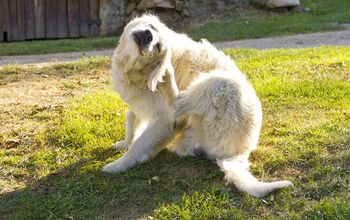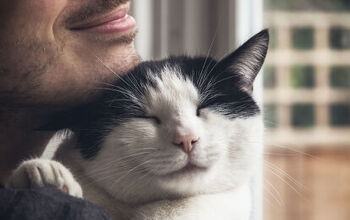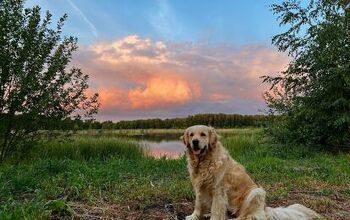What Do I Do if My Dog Has a Chipped Tooth?

Discovering that your dog is hurt or in pain is a concerning moment for any pet parent, regardless of the injury. But dental injuries can be particularly stressful. If you have ever experienced a toothache, you understand!
Whether your pup chipped a tooth during a rough play session with their best furry friend or while gnawing on a hard chew like a bone or antler, any dental damage must be addressed promptly.
Read on to learn how to prioritize your dog’s dental health, including identifying if they may be suffering from a broken or chipped tooth, how to address dental damage and tips for preventing a broken tooth before it happens. Your pup will thank you!
Common Signs of a Broken or Chipped Tooth
The first step to caring for dental problems is to identify that your dog is experiencing an issue. The signs of dental problems vary considerably. While some dogs won’t show any discomfort, others may demonstrate considerable pain. This is due not only to the difference in a dog’s personality and pain threshold but also the spectrum of injuries that fall under the heading of “dental problems.”
Broken teeth can be categorized into three groups:
- Enamel Fractures: Damage only to the enamel of the tooth.
- Crown Fractures: Damage extends deeper into the tooth, breaking the crown and exposing the pulp.
- Root Fractures: The root of the tooth has been broken.
Unless you inspect your dog’s teeth regularly and spot a problem, we often have to rely on body language and behavioral changes to know there’s a problem. Unfortunately, dogs are very good at hiding pain, so they may be suffering from a problem for a while before we’re aware that there is an issue.
Some of the more common signs of a broken or chipped tooth include:
- Excessive drooling
- Bloody saliva
- Pawing at their muzzle
- Chewing on one side of the mouth
- Reluctancy to eat and kibble or harder-to-chew items
- Refusal to eat at all
- Avoiding drinking cold water
- Grinding teeth
- Swelling in the face
- Discomfort or reluctance to have muzzle touched
- Whining or whimpering
- Not playing as they would normally
- Sudden or out-of-character aggressive or anxious behavior
- Trembling or shaking
Does A Dog’s Chipped Tooth Need to Be Fixed?
If you suspect that your dog is suffering from a broken or chipped tooth, it should be addressed as soon as possible. These aren’t conditions that get better on their own. Unlike a small cut or scrape, the tooth will not regenerate or heal itself. Instead, even the most minor crack will likely continue to get worse. If your dog isn’t already experiencing pain, they will.
Plus, not addressing the problem risks the development of severe and potentially life-threatening infections.
Contact your veterinarian and explain the situation. Depending on the injury and the level of discomfort your dog is currently experiencing, they may make an appointment or ask you to come in right away for immediate care.
How Do You Tell if A Dog’s Broken Tooth Is Infected?
One of the biggest concerns when dealing with dental injuries is the risk of a tooth developing an infection or abscess. However, identifying an infection isn’t always easy until it has progressed considerably. You may notice redness or swelling on the gums around the tooth, but these symptoms can also result from trauma to the area when the tooth is broken.
Given the difficulty in knowing if the tooth has been infected and the potential long-term risks to your dog, we recommend treating every broken tooth as a possible infection.
This means you should be seeking veterinary care to address the injury. This same advice applies when discussing any dental problems your dog may suffer, including loose teeth, tooth loss, or signs of discomfort in that area that continue over several days (even if you can’t see a visible injury). Remember, as we previously mentioned, they are masters of hiding pain. If your dog is showing they are hurting, it may be far worse than they are letting on.
An untreated dental infection can spread, leading to:
- Further dental decay
- Prolonged pain and discomfort
- Damage to the jaw area
- Heart disease
- Severe systemic infections
What is the Treatment for a Broken Tooth in Dogs?
Like human dental problems, several approaches can be taken depending on the location and severity of the break. This includes doing restorative work to save the tooth (if it can be saved) or extracting the broken tooth entirely.
Restorative work may involve vital pulp therapy (removing a layer of the pulp to remove bacteria and inflamed tissue, then sealing the tooth with a dental composite or “filling”) or a root canal (removing all the pulp and diseased tissue before filling the tooth). If the tooth's crown is significantly damaged, a crown may also be placed on the tooth for added stability and protection. These steps are generally only taken for teeth considered “necessary,” like the canines and large premolars.
If the tooth is damaged beyond repair or it has been determined that the restorative work wouldn’t be the best option (due to cost or the recovery period for the dog), the tooth may simply be extracted.
t
Whether the tooth is saved or removed, your veterinarian will likely prescribe medication to address a possible infection. This is a key preventative step to ensure your dog will walk away from the situation both happy and healthy.
5 Tips to Prevent a Broken Tooth Before It Happens
The only thing better than addressing your dog’s tooth pain to give them relief quickly is to avoid these injuries entirely. Of course, not everything can be prevented. Accidents happen. But here are a few steps you can take to reduce the risk of a cracked or broken tooth:
Practice Regular At-Home Dental Care
One of the most critical steps to prevent a tooth from being broken or cracked is to prioritize your dog’s dental health. Often, dog parents assume this means that you must brush your dog’s teeth daily, with anything less being “not enough.” Unfortunately, not every dog will be open to the use of a toothbrush. So, let’s look at your options.
Brushing your dog’s teeth is the optimal approach. There are products to make this process easier for both you and your dog, including specialized toothbrushes created to help you reach their molars easily and fingerbrushes for those who are nervous about a traditional toothbrush. Ensure that you are using a dog-friendly toothpaste. Human toothpastes often contain toxic or harmful ingredients to our dogs, such as xylitol.
If you or your dog are uncomfortable with the process of brushing their teeth, there are other products that can help improve their dental health. Dental water additives and dental sprays both work to break down tartar. Water additives, in particular, are often tasteless, making it easy to address your dog’s dental care without them even realizing it. Other popular options that most dogs will happily incorporate into their daily routine are dental chews and dental toys, which work by scraping the tartar off their teeth as they chew.
Do Routine At-Home Dental Checks
As we already discussed, broken and chipped teeth aren’t always noticeable visually. If your dog’s chipped tooth is a back tooth, it could go unseen for weeks. One of the best ways to ensure that you aren’t missing or overlooking a problem is to do routine at-home dental health exams. This involves checking your dog’s teeth, mouth, and gums for any signs of concern.
Like brushing your dog’s teeth, this may involve some conditioning and training. You must teach your dog to be comfortable with having their muzzle handled. This is best accomplished by starting young, handling their muzzle regularly as young puppies while praising and rewarding them.
However, don't count them out if you have an older dog. The concept that you “can’t teach an old dog new tricks” is a myth. Your older dog can definitely learn to relax for an at-home dental exam with time and patience as you work through the conditioning process. Just don’t push them too quickly. Slowly ease into it while focusing on creating a positive experience.
Schedule Annual Dental Appointments
You are likely already in the habit of booking your dog’s yearly health checks with your veterinarian, but have you taken the step to incorporate dental checks and dental cleaning into that routine? A complete annual dental cleaning can be pricey, but like a human dental cleaning, it ensures that all tartar is carefully removed to prevent problems before they occur. I can speak from experience when saying that preventative costs can be much cheaper than the cost of dealing with a problem later in life!
If you aren’t already taking your dog to the vet for an annual dental cleaning, there is no better time to start. Contact your vet to talk about your dog’s dental history and your plans to work together as a team for their oral care moving forward. In addition to scheduling a cleaning, they may have other recommendations (some of which you’ll find on this list already) that you can incorporate into your regular routine.
Avoid Toys That Are Too Hard
When selecting toys for your dog, there are a few things to consider. First, look at their age and size. A large and overly hard toy for a young, small-breed puppy is asking for trouble. Second, ensure the toy isn’t too hard, especially if your dog is a chewer. Compressed nylon and plastic toys are often the worst culprits.
A general rule of thumb recommended among pet experts is to use your thumbnail to assess if a toy is too hard. If you press your thumbnail into the toy, does it indent slightly? If not, the toy is too hard.
Choose Safe, Tooth-Friendly Chews
Like toys, your dog’s chews may increase the risk of a broken or chipped tooth. Many veterinarians and dental health experts warn against giving your dog hard bones, antlers, and other often popular chews for this reason – especially if your dog is already suffering from dental damage or decay. The thumbnail rule outline above for toys can also be applied here.
If you have a heavy chewer, many great (and tooth-friendly) options are on the market. First, pay careful attention to your dog’s style of chewing. While one dog may slowly chew on and soften a product, another may try to snap it off instantly, increasing the risk of trouble. Second, take note that some chews help remove plaque and tartar build-up, contributing to better dental health.
Bully sticks are a popular choice among many dog parents. As your dog chews, they soften, making them a safer choice unless your dog is a power chewer who won’t wait for this to happen. Another softer option for dogs is beef trachea or fish skin chews. However, these products won’t last as long with a heavy chewer.
Are you unsure of the best option for your dog? We highly recommend connecting with the knowledgeable staff or management at your local pet store or starting the conversation with your veterinarian. They are familiar with the products available on the market and will help you make an educated decision.
Final Thoughts: What to Do if A Dog Has a Broken or Chipped Tooth
Dental injuries can be excruciating and, if left unaddressed, dangerous to your dog’s health. As dog parents, the best thing we can do is learn to recognize the warning signs of dental pain and address any problems that arise as soon as we discover them. Watch for signs of pain or discomfort, like heavy panting, pawing at their muzzle, or changes in their eating habits. Contact your veterinarian if you suspect your dog may be suffering from a broken tooth or toothache.
While we can’t prevent all accidents, we can reduce the risk by taking preventative steps. Prioritize regular dental care at home and inspect their teeth periodically. In addition to your dog’s regular annual health check, talk to your vet about including a yearly dental exam and cleaning. Finally, avoid giving your dog anything that is too hard to chew on (toys or treats). If you’re in doubt, err on the side of caution and select something a little softer.
Join the PetGuide community. Get the latest pet news and product recommendations by subscribing to our newsletter here.

Britt Kascjak is a proud pet mom, sharing her heart (and her home) with her “pack” which includes her husband John, their 2 dogs – Indiana and Lucifer – and their 2 cats – Pippen and Jinx. She has been active in the animal rescue community for over 15 years, volunteering, fostering and advocating for organizations across Canada and the US. In her free time, she enjoys traveling around the country camping, hiking, and canoeing with her pets.
More by Britt
























